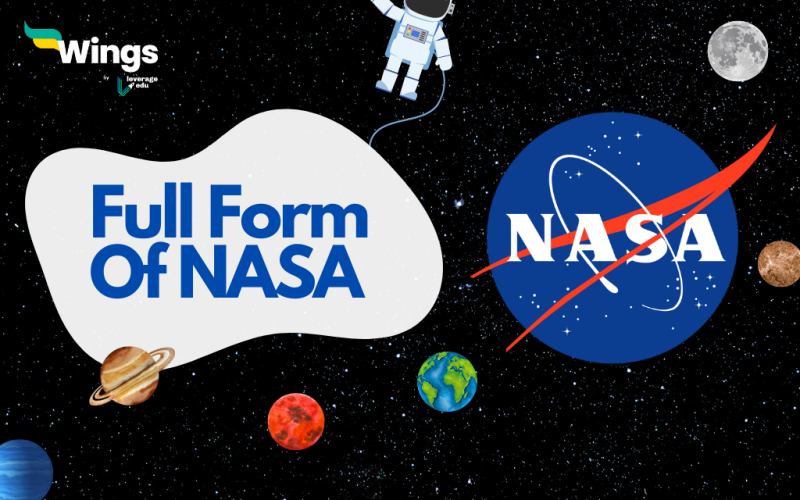The full form of NASA is the National Aeronautics and Space Administration. It is a renowned United States government agency responsible for civilian space programs, aeronautics, and aerospace research. In addition, NASA has been at the vanguard of scientific discovery, space exploration, as well as technical innovation. The administration pushes the boundaries of human knowledge and power in space exploration and scientific research. NASA moreover has a rich history of accomplishments and ongoing missions. Thus the agency continues to enlighten awe and curiosity about the vast expanse of our cosmos.
Why was NASA Created?
Table of Contents [show]
Now that you know the full form of NASA, let us talk about why was Nasa created really? NASA was created in response to the Soviet Union’s launch of the first artificial satellite, Sputnik 1, in 1957. The Cold War-era space race prompted the United States to establish NASA to ensure its leadership in space exploration and technology. Over the years, NASA’s mission has evolved to include a wide range of scientific and exploration objectives that range from studying the Earth’s atmosphere to exploring distant planets and galaxies.
Also Read: Types of NASA Jobs and Requirements
What are NASA’s Main Goals and Objectives?
The main goals and objectives of NASA are as follows:
- NASA’s primary goals revolve around exploration, scientific discovery, and technological advancement.
- The agency aims to expand human presence beyond Earth.
- NASA sends astronauts to explore the Moon, Mars, and beyond.
- Scientifically, NASA conducts cutting-edge research in areas such as astrophysics, heliophysics, planetary science, and Earth science.
- Additionally, NASA focuses on developing innovative technologies that benefit both space exploration and everyday life on Earth.
Also Read: How to Become a Scientist in NASA?
Crewed and Uncrewed Space Programs of NASA
Following are the crewed and uncrewed programs of NASA
Crewed Programs
- X to 15 rocket plane (1959-1968)
- Project Mercury (1958-1963)
- Project Gemini (1961-1966)
- Apollo program (1961-1972)
- Skylab (1965-1979)
- Apollo to Soyuz Test Project (1972-1975)
- Space Shuttle program (1972-2011)
- International Space Station (1993-Present)
Uncrewed Programs
- Explorer 1 to First U.S Uncrewed satellite (1958)
- Pioneer 10 to First spacecraft to visit Jupiter(1973).
- Pioneer 11 to First spacecraft to visit Saturn (1979)
- Voyager 2 to First spacecraft to visit Uranus in 1986 and Neptune in 1989.
Main Achievements of NASA
Furthermore, here are some notable achievements of NASA:
- The Apollo moon landing saw humans set foot on the lunar surface for the first time in 1969.
- The Space Shuttle program which was operational from 1981 to 2011 revolutionized space travel by providing a reusable spacecraft.
- The Hubble Space Telescope which was launched in 1990 has captured breathtaking images and significantly advanced our understanding of the universe.
- More recently, NASA’s Perseverance rover successfully landed on Mars in 2021 thus continuing the exploration of the Red Planet.
Some Interesting Facts About NASA
- Project Mercury was NASA’s first project.
- It was NASA scientists who invented the Super Soaker Squirt Gun.
- NASA’s headquarters is located at 300 E. Street SW in Washington, DC.
- NASA was the successor to NACA (National Advisory Committee for Aeronautics).
- American flags that flew on two separate Moon missions hang in NASA’s mission control room.
- In NASA’s last astronaut recruitment, 6000 applications were received for 8 posts.
- NASA’s first manned spacecraft was Freedom 7 and was launched on May 15, 1961 by Alan B. Took Shepard Jr. into space.
- NASA’s slogan is “Exploring the Universe and Searching for Life; “To inspire the next generation of explorers, as only NASA can.”
- Columbia was NASA’s first spacecraft. On February 1, 2003, on its 28th mission, it broke into pieces over Texas during re-entry.
Popular Full Forms
We hope this blog has helped you understand the full form of NASA and everything related to it. If you want to know more, find the 300+ full forms list on our blog. In the world of short forms, you can rely on the Leverage edu page to know about more full forms like this! Connect with us study abroad experts to achieve your international dream today!
 One app for all your study abroad needs
One app for all your study abroad needs















 45,000+ students trusted us with their dreams. Take the first step today!
45,000+ students trusted us with their dreams. Take the first step today!
